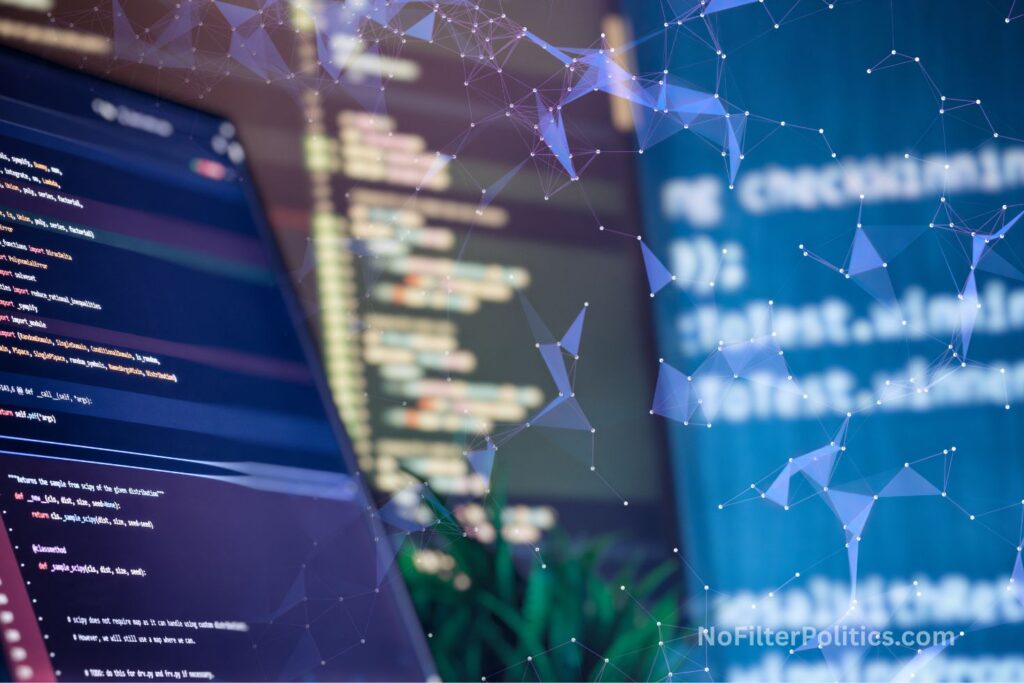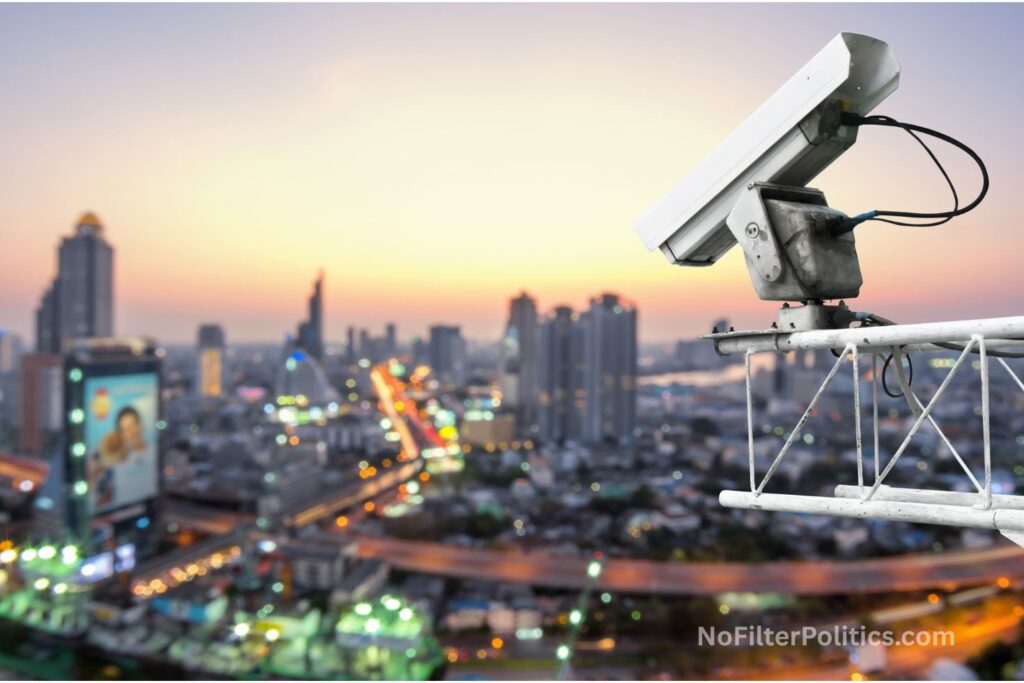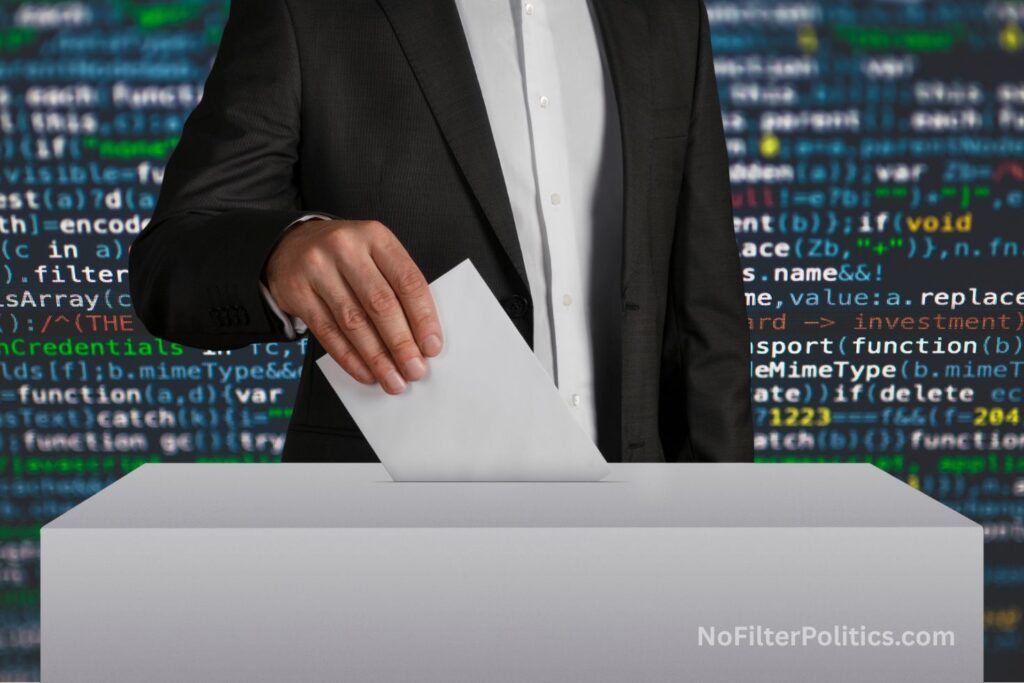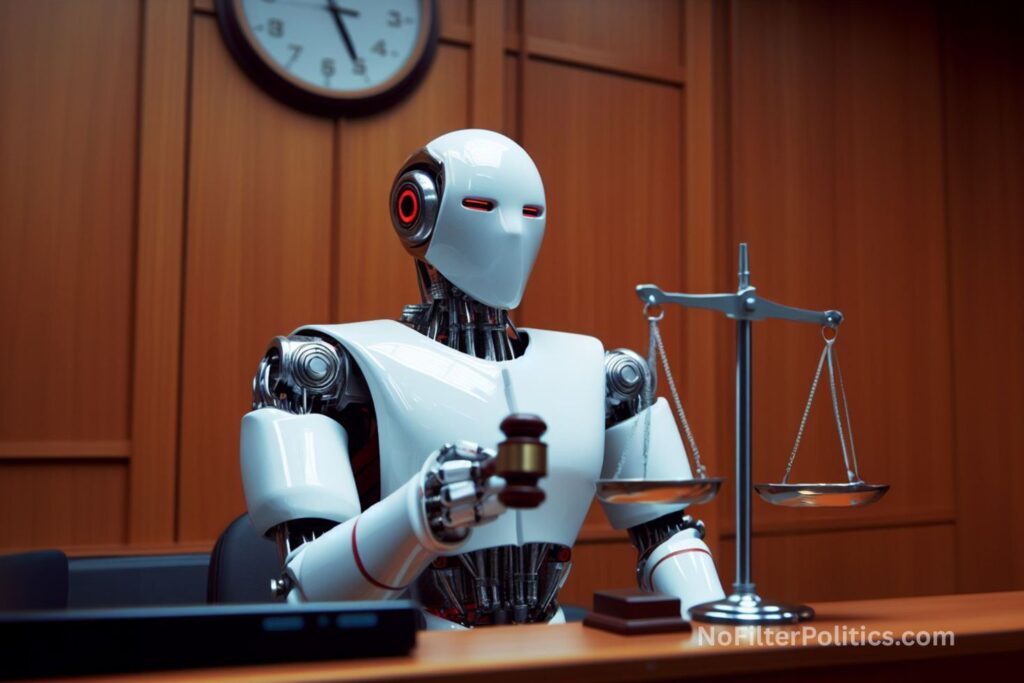AI Is Watching, Lying, and Winning — The War for America’s Mind Has Begun
Artificial intelligence isn’t coming — it’s already here. It watches from the cameras on city corners, whispers through the ads on your social feed, and writes half the headlines you scroll past each morning. Once a tool of convenience and innovation, AI has become something far more consequential: a quiet force reshaping how Americans are surveilled, persuaded, and misinformed.
Across the United States, artificial intelligence has fused with government surveillance, political campaigning, and media manipulation to create a system of influence unprecedented in reach and speed. Whether in a police department using facial recognition to identify suspects, a campaign war room deploying machine learning to craft targeted messages, or a network of bots flooding the digital public square with propaganda, AI is now the invisible architecture of modern power.
This isn’t science fiction. It’s policy, profit, and politics — happening in real time, mostly without public consent.
To understand the scale of what’s unfolding, it’s worth tracing how we got here — and who’s really benefiting from this algorithmic revolution.
A Brief History of the Machine State

The roots of AI-driven governance trace back decades. During the Cold War, U.S. intelligence agencies poured billions into early computing systems designed for pattern recognition and codebreaking. In the 1990s, that infrastructure expanded into the internet age — the National Security Agency’s data collection programs, facial recognition research at DARPA, and predictive analytics in law enforcement were all precursors to today’s AI ecosystem.
After 9/11, the Patriot Act and the rise of the “War on Terror” fundamentally altered the balance between privacy and security. Surveillance programs once aimed at foreign threats turned inward. The NSA’s PRISM system — revealed by Edward Snowden in 2013 — showed how easily vast data troves from private companies could be mined for intelligence. That revelation marked the dawn of algorithmic surveillance at scale.
By the mid-2010s, as social media companies like Facebook and Google perfected user profiling for advertising, Silicon Valley and Washington discovered a shared interest: data. What began as a business model for personalized ads became a political and security apparatus powered by machine learning.
Today, artificial intelligence sits at the intersection of corporate profit, state power, and human behavior. The line between technological innovation and social control has blurred to the point of invisibility.
Surveillance — America’s Digital Panopticon

If the 20th century’s surveillance state relied on human intelligence, the 21st century’s relies on artificial intelligence. Across the United States, AI now powers facial recognition systems, predictive policing algorithms, and public-private data-sharing networks that track citizens’ movements and behaviors — often without their knowledge.
The Rise of Facial Recognition
At the heart of this transformation is facial recognition technology. Once a novelty, it has evolved into a nationwide infrastructure of surveillance. Police departments, airports, border agencies, and even schools now deploy software that can identify individuals in real time from security cameras and smartphone databases.
The problem? There are virtually no federal laws regulating its use. The FBI, Department of Homeland Security, and local law enforcement agencies all operate under fragmented guidelines. Some states, like Illinois and Maryland, have implemented biometric privacy laws. Others, like Texas and New York, have resisted broad regulation, leaving citizens exposed to misidentification and abuse.
Studies have shown that these systems misfire far more frequently for women and people of color. At least eight Americans have been wrongfully arrested based on faulty AI matches — a direct result of software bias. For those individuals, the human cost of “smart policing” was lost jobs, reputational ruin, and trauma.
The technology’s defenders claim it helps solve crimes faster and protect communities. But the evidence is mixed. Many departments fail to track accuracy rates or disclose how facial recognition is used in investigations. Some cities, like San Francisco and Boston, banned it altogether — only to see police quietly outsource scans to neighboring jurisdictions with looser laws.
It’s a loophole as large as the databases feeding these systems.
Predictive Policing: Minority Report for Real
Equally controversial is predictive policing — the use of AI to forecast where crimes will occur or who might commit them. Police departments across the country, from Chicago to Los Angeles, have experimented with algorithms that claim to “optimize patrol routes” or identify “high-risk individuals.”
In practice, these models often replicate existing biases. Crime data reflects policing patterns, not objective crime rates. Feed those patterns into a machine, and it learns to target the same neighborhoods again and again. The result is a feedback loop of over-policing in minority communities and under-policing elsewhere — a digital version of institutional bias.
Chicago spent millions on its predictive policing pilot program only to scrap it after auditors found no measurable impact on crime reduction. Los Angeles abandoned its version for similar reasons. Still, new startups keep selling “crime forecasting” software to cash-strapped cities desperate for results.
The outcome is predictable: private companies profit, law enforcement gains expanded reach, and civil liberties erode under the banner of efficiency.
Private Profit Meets Public Power
The modern surveillance state is as much corporate as it is governmental. Companies like Clearview AI, Palantir Technologies, and Amazon have built entire business models around selling surveillance capabilities to police and federal agencies. Clearview, for instance, scraped billions of images from social media platforms to create a facial recognition database now used by hundreds of law enforcement entities.
These partnerships blur the line between public oversight and private control. The incentives are misaligned: governments seek security, corporations seek profit, and the citizen becomes the data product.
Add in the growing network of private cameras — from Ring doorbells to retail store systems — and America has quietly built a distributed surveillance grid with little accountability. Each new device adds another node in a vast, mostly invisible web of data collection.
The justification is always safety. The reality is something closer to a digital panopticon, where the watchers are no longer human, and the watched rarely know they’re being seen.
Elections — The Algorithmic Campaign

If AI surveillance threatens privacy, AI in elections threatens democracy itself. Political campaigns, super PACs, and foreign adversaries alike have discovered that machine learning is the ultimate persuasion tool — capable of predicting not just what voters think, but how to make them feel.
Microtargeting and Manipulation
Campaigns have used data analytics for years, but artificial intelligence supercharges it. Machine learning systems analyze voter rolls, social media activity, online shopping habits, and even streaming preferences to predict political leanings and emotional triggers.
With generative AI, campaigns can now produce thousands of customized messages — text, video, and audio — tailored to specific demographic slices. One voter might see a heartfelt ad about jobs and families; another might be shown a fear-driven clip about immigration or crime. Both are designed by algorithms to exploit personal biases.
This level of microtargeting is nearly impossible to detect, and current election laws offer no real safeguard against it. The Federal Election Commission regulates spending and disclosure, but not algorithmic influence. The result is a Wild West of political messaging — personalized propaganda without transparency.
Deepfakes and Synthetic Candidates
In 2024, the Republican National Committee released the first major AI-generated political ad, featuring hyper-realistic images of chaos in a hypothetical second Biden term. It was labeled as AI-generated — but it set a precedent. The boundary between reality and fiction in campaign media had been permanently breached.
Soon after, an anonymous robocall surfaced featuring an AI-generated imitation of President Biden’s voice, telling voters to stay home. It was a hoax, but the damage was real.
These are early examples of a much larger threat: synthetic media capable of eroding trust in every image, video, and voice we encounter. When voters can no longer distinguish truth from fabrication, democracy loses its foundation of shared reality.
Some states have attempted to intervene. Texas and California now require disclaimers on AI-altered political ads. But regulation is fragmented, and enforcement is weak. The Federal Election Commission has so far refused to ban AI deepfakes outright, leaving the issue to individual states.
Meanwhile, the technology continues to advance — faster than the law can keep up.
The Economics of Influence
AI isn’t just a weapon of persuasion; it’s a business. Data brokers, marketing firms, and political consultants profit handsomely from the new frontier of algorithmic campaigning. Smaller candidates, once constrained by limited budgets, can now use AI to generate professional-grade content at a fraction of the cost.
This democratizes access to tools — but also to deceit. When every campaign can cheaply flood the digital space with personalized propaganda, truth becomes a casualty of efficiency.
Foreign adversaries see opportunity, too. Russian and Chinese influence operations have begun experimenting with AI-driven disinformation networks that mimic legitimate domestic voices, amplifying division from within. The next major election interference campaign may not need hackers or fake news farms — just a fleet of chatbots that sound convincingly American.
Misinformation — The Firehose of Falsehood

If elections reveal how AI manipulates perception, the broader information ecosystem shows how it floods the public square with noise. AI has become the engine of misinformation — not only producing fake content, but optimizing it for maximum emotional impact.
Deepfakes and the Collapse of Reality
The ability to generate realistic audio and video has obliterated traditional evidence hierarchies. What used to serve as proof — a recording, a photograph — can now be fabricated with minimal effort. Deepfakes are no longer crude parodies; they are tools of persuasion, blackmail, and political warfare.
As generative models improve, so does the difficulty of debunking their output. Detection software can flag manipulations, but the process is always reactive. By the time a deepfake is disproven, it may have already influenced millions.
This erosion of trust doesn’t require mass belief in a single falsehood. It simply breeds doubt in all sources of information. When every video could be fake, truth itself becomes negotiable.
AI-Generated Content Farms
Beyond video, AI now powers entire networks of text-based misinformation. Automated content farms generate politically charged articles, fake local news sites, and social media posts designed to mimic authentic grassroots movements.
A single operator can deploy hundreds of AI “writers” producing thousands of posts per day — optimized for keywords, sentiment, and shareability. These narratives spread faster than fact-checkers can respond.
Even legitimate outlets feel the pressure. Newsrooms experimenting with AI-generated summaries or headlines sometimes blur the line between editorial judgment and algorithmic production, further muddying the waters of trust.
The result is a chaotic information marketplace where the loudest voice wins — even if it belongs to a machine.
Bot Networks and Emotional Engineering
On social media, AI-driven bots amplify divisive content at scale. They don’t need to be perfect imitations of humans — they just need to appear numerous. A few thousand coordinated bots can create the illusion of mass opinion, nudging real users toward outrage or apathy.
Machine learning models identify which topics spark engagement and escalate them through automated posting and reaction patterns. Political operatives, extremists, and foreign actors all exploit this dynamic to manipulate public sentiment.
These bots don’t just spread lies; they weaponize emotions. Fear, anger, and disgust drive engagement — and engagement drives algorithms. The platforms themselves profit from this attention economy, making misinformation not just a byproduct but a revenue stream.
Who Benefits — and Who Doesn’t

Artificial intelligence in surveillance, elections, and misinformation serves a common master: control. Governments seek control through data. Corporations seek control through profit. Political campaigns seek control through persuasion.
The winners of this system are those who hold the levers of information — the ones who can see without being seen, influence without accountability, and profit without transparency.
The losers are ordinary citizens. The erosion of privacy, the manipulation of perception, and the collapse of trust all flow downhill. Each new innovation in AI promises empowerment but often delivers dependency. Each advance in efficiency comes at the cost of autonomy.
America’s AI revolution, in other words, has democratized neither power nor knowledge. It has centralized both.
The Legal and Ethical Battlefield

The United States lags behind much of the developed world in regulating artificial intelligence. Europe’s AI Act, though imperfect, establishes clear categories for acceptable and prohibited uses. In contrast, America’s approach remains fragmented — a patchwork of state laws, executive orders, and voluntary industry pledges.
At the federal level, AI oversight is divided among agencies with overlapping jurisdictions: the FTC for consumer protection, the DOJ for civil rights enforcement, the FEC for elections, and the FCC for communications. None possess comprehensive authority over AI’s societal impact.
Ethically, the questions cut deeper than regulation. What does consent mean when data is harvested invisibly? What does truth mean when machines can fabricate evidence? What does democracy mean when algorithms can predict — and influence — your vote before you cast it?
Without strong safeguards, AI risks becoming a mechanism of soft authoritarianism: control not through force, but through information asymmetry.
Conclusion: The Fight for Control
Artificial intelligence has given America extraordinary capabilities — but also unprecedented vulnerabilities. It has made government more powerful, corporations more omniscient, and citizens more exposed. It has blurred the boundaries between truth and fiction, privacy and publicity, autonomy and manipulation.
The question is no longer whether AI will shape the future. It already has. The real question is who will shape AI — and for whose benefit.
If history is any guide, technology always serves the interests of those who wield it. But democracy demands the opposite: that power be accountable to the people. That balance is now under threat.
The path forward requires more than regulation. It requires civic literacy, transparency, and moral courage — the willingness to confront not just what AI can do, but what it should do.
The machines are not sentient. They reflect human priorities. The danger lies not in their intelligence, but in the blindness of those who deploy them.
Artificial intelligence is not the end of freedom — but it could be, if we fail to draw the line between innovation and control. The future of privacy, democracy, and truth itself depends on whether we act while we still can.
References
-
Federal Election Commission. “FEC Makes Public Draft Documents Regarding Artificial Intelligence in Campaign Ads.” FEC.gov, Sept. 19, 2024. https://www.fec.gov/updates/fec-makes-public-draft-documents-regarding-artificial-intelligence-in-campaign-ads/
-
U.S. Commission on Civil Rights. “The Civil Rights Implications of the Federal Use of Facial Recognition Technology.” USCCR.gov, Sept. 19, 2024. https://www.usccr.gov/reports/2024/civil-rights-implications-federal-use-facial-recognition-technology
-
Federal Election Commission. “Statement by Vice Chair Weintraub on AI in Campaign Ads – FEC.” FEC.gov. https://www.fec.gov/documents/5503/REG-2023-02-A-in-Campaign-Ads-Vice-Chair-Statement.pdf
-
The Conference Board (CED). “FEC Interpretive Rule on AI in Political Ads: Policy Backgrounder.” Conference-Board.org. https://www.conference-board.org/research/ced-policy-backgrounders/fec-interpretive-rule-on-ai-in-political-ads
-
Brennan Center for Justice. “Regulating AI Deepfakes and Synthetic Media in the Political Arena.” BrennanCenter.org. https://www.brennancenter.org/our-work/research-reports/regulating-ai-deepfakes-and-synthetic-media-political-arena
-
National Conference of State Legislatures. “Summary: Artificial Intelligence (AI) in Elections and Campaigns.” NCSL.org, Sept. 2024. https://www.ncsl.org/elections-and-campaigns/artificial-intelligence-ai-in-elections-and-campaigns
-
Congress (Library of Congress, CRS). R. Sam Garrett. “Artificial Intelligence (AI) and Campaign Finance Policy: Recent Developments.” CRS Insight IN12222, Sept. 25, 2024. https://www.congress.gov/crs-product/IN12222
-
National Law Review. “Constitutional Rights Issues Under Predictive Policing.” NatLawReview.com. https://natlawreview.com/article/ai-police-surveillance-bias-minority-report-impacting-constitutional-rights
-
Federal Election Commission. “Commission Approves Notification of Disposition, Interpretive Rule on Artificial Intelligence in Campaign Ads.” FEC.gov, Sept. 10, 2024. https://www.fec.gov/updates/commission-approves-notification-of-disposition-interpretive-rule-on-artificial-intelligence-in-campaign-ads/
-
FedScoop. “Civil Rights Commission Finds ‘Concerning Lack of Federal Oversight’ of Facial Recognition Technology.” FedScoop.com, Sept. 19, 2024. https://fedscoop.com/facial-recognition-technology-civil-rights-commission-us-government/
Discover more from Timothy Alexander
Subscribe to get the latest posts sent to your email.